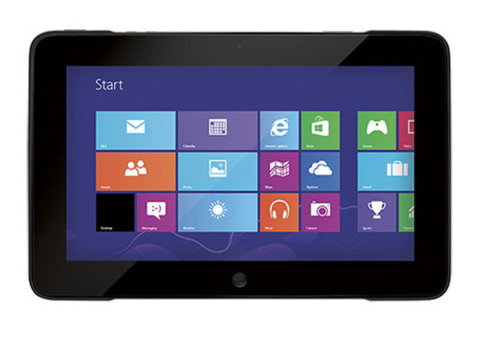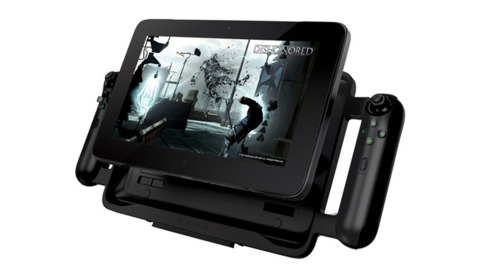Razer's Innovative Edge Gaming Tablet Is a Risky Proposition
The Edge offers a lot of gaming power for a tablet, but it requires costly accessories to realize its full potential.
You've heard it before: "Gaming is everywhere." However, no one's saying that gaming is perfect everywhere. Generally, the form and function of gaming hardware define the types of games that work best. Therefore, it's interesting to see how the recent advent of high-powered tablets has begun to blur the line between stationary and mobile gaming.

Razer's Edge gaming tablet is a perfect example. It's crammed full of modern components, capable enough to support the latest DirectX 11 PC games, and is designed to work in tandem with a slew of accessories tailored for a variety of scenarios. It's slightly larger than most tablets, and definitely more expensive, but that isn't surprising once you realize what's under the hood.
| Display | ||
|---|---|---|
| CPU | ||
| GPU | ||
| RAM | ||
| Storage | ||
| Price |
These parts, at least in the case of the Pro model Razer supplied for testing, are definitely good enough for gaming. After we put BioShock Infinite through its paces on the high-end Edge, it's obvious that it's possible to generate decent frame rates, but you will have to dial back a few graphical flourishes.
Note: V-Sync was disabled during benchmarking, resulting in the partial and torn frames found in the video below.
Marvel Rivals - Official Loki Character Reveal Trailer | The King of Yggsgard Remnant 2 - The Forgotten Kingdom | DLC Launch Trailer Stellar Blade - Official "The Journey: Part 2" Behind The Scenes Trailer | PS5 Games Fortnite Festival - Official Billie Eilish Cinematic Season 3 Trailer Dead by Daylight | Tome 19: Splendor | Reveal Trailer Destiny 2: The Final Shape | Journey into The Traveler Trailer Starship Troopers: Extermination - Official "The New Vanguard" Update 0.7.0 Trailer 2XKO - Official Illaoi Champion Gameplay Reveal Trailer Solo Leveling: Arise - Character Gameplay Teaser #15: Seo Jiwoo Genshin Impact - Character Demo - "Arlecchino: Lullaby" Goddess Of Victory: Nikke | Last Kingdom Full Animated Cinematic Trailer Metaphor: ReFantazio The King’s Trial Trailer
Please enter your date of birth to view this video
By clicking 'enter', you agree to GameSpot's
Terms of Use and Privacy Policy
Now, despite the form factor, the Edge is a full-fledged PC, running Microsoft's tablet friendly Windows 8 OS. Since it's practically infeasible to play most PC games with a touch screen alone, you inevitably need to add inputs to make use of the Edge as a gaming device. It's probably too early in the tablet PC game to expect developers to retroactively update their libraries for a touch screen, after all. In other words, you'll want to pick up one of the three attachments to get the most out of your tablet.
With the full kit, the Edge can be played in the living room, at a desk, and on the go, with support for the sorts of inputs you'd expect. A configurable and unified gaming device is untraditional, but the benefits of a single, portable platform are definitely worth exploring. Unfortunately, getting a taste of Razer's take on this vision doesn't come cheap. The price you pay for the Edge accounts only for the tablet. The keyboard dock (currently unavailable), GamePad, and docking station have to be purchased separately.

The docking station is the cheapest attachment out of the lot at $100, but it provides a lot of useful functionality compared to the more expensive and specialized GamePad controller. First off, it provides a convenient way to charge and mount the tablet. Without the dock, you have to manually connect the slightly awkward power cable and lay the tablet flat. Outside of the obvious benefits, the back of the dock provides an array of useful connections: 3 USB ports, HDMI-out, and 2.5mm audio in and out ports, in addition to the power connection. Compared to the tablet on its own, which provides only a single USB port and 3.5mm audio port, the dock expands the potential of the mighty tablet in a much needed way. Unfortunately, the angle of the tablet while docked is a bit too acute for desktop use without inconveniently wedging something underneath the base.
As you might guess, the HDMI port on the back of the dock makes connecting the Edge to a TV a relatively simple affair. You may need to change a setting or two within Windows to mirror or extend the desktop, but these preferences are saved within the operating system on a per-display basis. Keep in mind, however, that the BioShock benchmark ran at 720p; connecting the Edge to a 1080p display will significantly impact its performance. In this case, it's best to scale back the Edge's output resolution to 720p within Windows.
Once you've got the display hooked up, all that's left to do is connect a Windows-supported USB controller. With an Xbox 360 controller, Steam in Big Picture Mode, and the Edge connected to your TV, you are, in essence, as close to a "Steam Box" as any other configuration on the market today. You also have the benefits of a home theater PC with a touch-screen interface. With the additional USB ports, display connectivity, and convenient charging setup, the dock seems to be a must-buy accessory for an Edge owner. One caveat: unless you attach an Ethernet to USB adapter, you're limited to Wi-Fi connectivity out of the box.
At $250, the GamePad controller adapter isn't as easy to recommend. When the Edge was simply known as the "Project Fiona" concept design, the hallmark feature was the dual analog controller built into the chassis. The attraction was, and still is with the Edge's GamePad, a mobile PC gaming device with tried-and-true controls at the ready. Truly, you only need to snap the Edge into the GamePad controller's chassis, and you have access to the equivalent of an Xbox 360 controller, with an added pair of shoulder buttons to boot. You also get a bit of extended battery life (and heft) with the optional $69, 2800mAh battery back on the inside of the GamePad. Considering that the Edge's stock battery barely lasts two hours while gaming, the extra juice might be worth investing in.
In theory, the GamePad controller should make mobile PC gaming a reasonable activity, and technically, it does. However, there are a few complications that make it less than ideal. For starters, the Edge tablet, weighty enough at 2.1 pounds, becomes a truly beefy device when the GamePad comes into play, topping off at 4.16 pounds (4.86 with the AC adapter). If you're sitting in a chair with comfortable armrests, the weight becomes less of an issue. Otherwise, it's nearly infeasible to support the weight of the devices and also play at your best for an extended period of time. The remarkable weight makes focusing your dexterity on the controls an issue, and the form of the grips doesn't do the Edge any favors either. Are the handles OK? Yes, but they aren't comfortable. Where the handles are completely straight, most controllers are bowed outward to accommodate the form of the controller in relation to our bodies. In the end, the GamePad is too large, slightly uncomfortable, and far too expensive to recommend.
The Edge is an interesting product; it's a transformable device that is, in theory, many things at once. It can handle modern PC games reasonably well without succumbing to the bottom-of-the-barrel settings, so far as the Pro model is concerned. The dock provides an elegant solution for connecting a PC to your TV or home theater, while also expanding the raw functionality and overall usefulness of the core tablet. There's not as much to be optimistic about regarding the controller, and that, along with its high cost, deflates the Edge's desirability as a mobile PC gaming device.
It's true that the Edge's performance is a bit under par given the relative cost of each model, but it's rare to see so much power in such a small package. Ultimately, its value comes down to your needs. For the casual player with an interest in tablets, it's hard to recommend the Edge. If you're the sort of player who usually uses a console, the Edge won't provide a significant enough leap in performance to justify the cost of the four, or more, current-gen consoles it takes to get there.
However, if you're a dedicated PC user with a dated rig, a burning desire for a tablet, and a console-like connection to your TV, then the cost of the Edge and the dock connector looks a bit less absurd. It solves all of the aforementioned issues in one fell swoop. The problem exists when you already own the devices the Edge is supposed to replace. If the Edge came with every one of its planned accessories, at the same base cost, it would make more people think twice before brushing it off. For now, investing in an Edge is recommended only if you have money to burn, and the need for such a convertible, all-in-one device.
Got a news tip or want to contact us directly? Email news@gamespot.com



Join the conversation